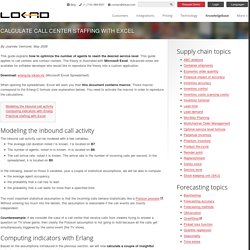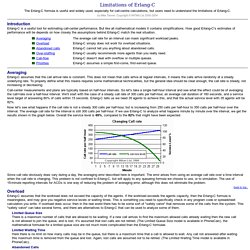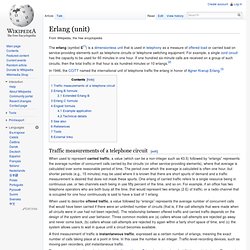

Mitan library. Calculate Call Center Staffing with Excel (Erlang formula) By Joannès Vermorel, May 2008 This guide explains how to optimize the number of agents to reach the desired service level.

This guide applies to call centers and contact centers. The theory is illustrated with Microsoft Excel. Advanced notes are available for software developer who would like to reproduce the theory into a custom application. Download: erlang-by-lokad.xls (Microsoft Excel Spreadsheet) When opening the spreadsheet, Excel will warn you than this document contains macros. Modeling the inbound call activity The inbound call activity can be modeled with a few variables: The average call duration noted t is known. t is located on B7.The number of agents, noted m is known. m is located on B8.The call arrival rate, noted λ is known. Computing indicators with Erlang Based on the assumptions introduced in the previous section, we will now calculate a couple of insightful indicators that reflect the call center activity.
Practical staffing with Excel A couple of remarks. Limitations of Erlang-C. The Erlang-C formula is useful and widely used, especially for call-centre calculations, but users need to understand the limitations of Erlang-C. by Mike Tanner.

Copyright © MITAN Ltd 2000-2004 Introduction Erlang-C is a useful tool for estimating call-center performance. But like all mathematical models it contains simplifications. Averaging Erlang-C assumes that the call arrival rate is constant. Call-center measurements and plans are typically based on half-hour intervals. Now let's see what happens if the call rate is not a steady 300 calls per half-hour, but is increasing from 250 calls per half-hour to 350 calls per half-hour over the interval. Since call rate obviously does vary during a day, the averaging error described here is important.
Back to top.. Overload Erlang-C assumes that the workload does not exceed the capacity of the agents. Limited Queue Size There is a maximum number of calls that are allowed to be waiting. Limited Waiting Time Abandoned Calls Abandoned Calls. Erlang C Calculator. Cc-Modeler Lite is the ultimate, easy-to-use Erlang C tool - it simplifies the analysis of call center staffing requirements and service performance.

It uses the industry-standard Erlang C traffic model, as well as simulation. cc-Modeler is powerful and quick, with many features not found in other Erlang C calculators. It is suitable for any size of operation, from a help desk right through to large call centers with hundreds of agents. The key to understanding the performance of your operation is to focus on the telephone basics - call volumes, talk times, agent availability, delay before answer, abandonment rate and maximum time in queue. Call center performance is typically measured across several key areas, including for example - Cost per call Resolution rate or fulfilment rate Customer satisfaction For example - If there are protracted queuing delays in peak periods, callers hang up. Erlang (unit) The erlang (symbol E[1]) is a dimensionless unit that is used in telephony as a measure of offered load or carried load on service-providing elements such as telephone circuits or telephone switching equipment.

For example, a single cord circuit has the capacity to be used for 60 minutes in one hour. If one hundred six-minute calls are received on a group of such circuits, then the total traffic in that hour is six hundred minutes or 10 erlangs.[2] In 1946, the CCITT named the international unit of telephone traffic the erlang in honor of Agner Krarup Erlang.[3] When used to represent carried traffic, a value (which can be a non-integer such as 43.5) followed by “erlangs” represents the average number of concurrent calls carried by the circuits (or other service-providing elements), where that average is calculated over some reasonable period of time. The concepts and mathematics introduced by Agner Krarup Erlang have broad applicability beyond telephony. Where: 1. The Erlang-C Formula - An Introduction.